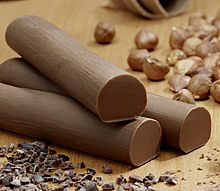food.wikisort.org - Dish
Gianduia or gianduja (Italian: [dʒanˈduːja];[1] Piedmontese: giandoja [dʒaŋˈdʊja]) is a homogeneous blend of chocolate with 30% hazelnut paste, invented in Turin during Napoleon's regency (1796–1814). It can be consumed in the form of bars or as a filling for chocolates. Chocolate spreads are also notably made from gianduja.
 Gianduja bars | |
| Type | Chocolate |
|---|---|
| Place of origin | Italy |
| Region or state | Turin, Piedmont |
| Main ingredients | Chocolate paste, hazelnut paste |
Gianduja is made in both plain and milk versions. It may also contain other nuts, such as almond.[2] As a bar, gianduja resembles regular chocolate, excepting the fact that it is significantly softer due to the presence of hazelnut oil.[3]
History
The Continental System, imposed by Napoleon in 1806, prevented British goods from entering European ports under French control, putting a strain on cocoa supplies.[4] A chocolatier in Turin named Michele Prochet extended the little chocolate he had by mixing it with hazelnuts from the Langhe hills south of Turin.[5] From a base of gianduja, Turin-based chocolate manufacturer Caffarel invented gianduiotto in 1852.[6]
It takes its name from Gianduja, a Carnival and marionette character who represents the archetypal Piedmontese, natives of the Italian region where hazelnut confectionery is common.
See also
- Nutella, which was originally called Pasta Gianduja[7]
- Gianduja (fr.wikibooks)
- Crema gianduia (it.Wikipedia)
References
- "Focus on Gianduia, Part 1.5: Orthography and Pronunciation – DallasFood". dallasfood.org.
- Beckett, Steve T. (2011). "Gianduja chocolate". Industrial Chocolate Manufacture and Use. John Wiley & Sons. ISBN 9781444357554.
- Medrich, Alice (2015). Pure Dessert: True Flavors, Inspiring Ingredients, and Simple Recipes. Artisan Books. p. 157. ISBN 9781579656850.
gianduja resembles a bar of chocolate. It is softer to the tooth than a plain chocolate bar (because of the oil from the hazelnuts)
- Elena Kostioukovitch (2009) Why Italians Love to Talk About Food p.95, Farrar, Straus and Giroux, ISBN 978-0374289942
- "Turin's chocolatiers" (Feb 2013) Gourmet Traveller Magazine
- "Caffarel – Finest Chocolate and the Best Hazelnuts". Caffarel.
- The History of Nutella Archived 2015-09-12 at the Wayback Machine
Другой контент может иметь иную лицензию. Перед использованием материалов сайта WikiSort.org внимательно изучите правила лицензирования конкретных элементов наполнения сайта.
WikiSort.org - проект по пересортировке и дополнению контента Википедии